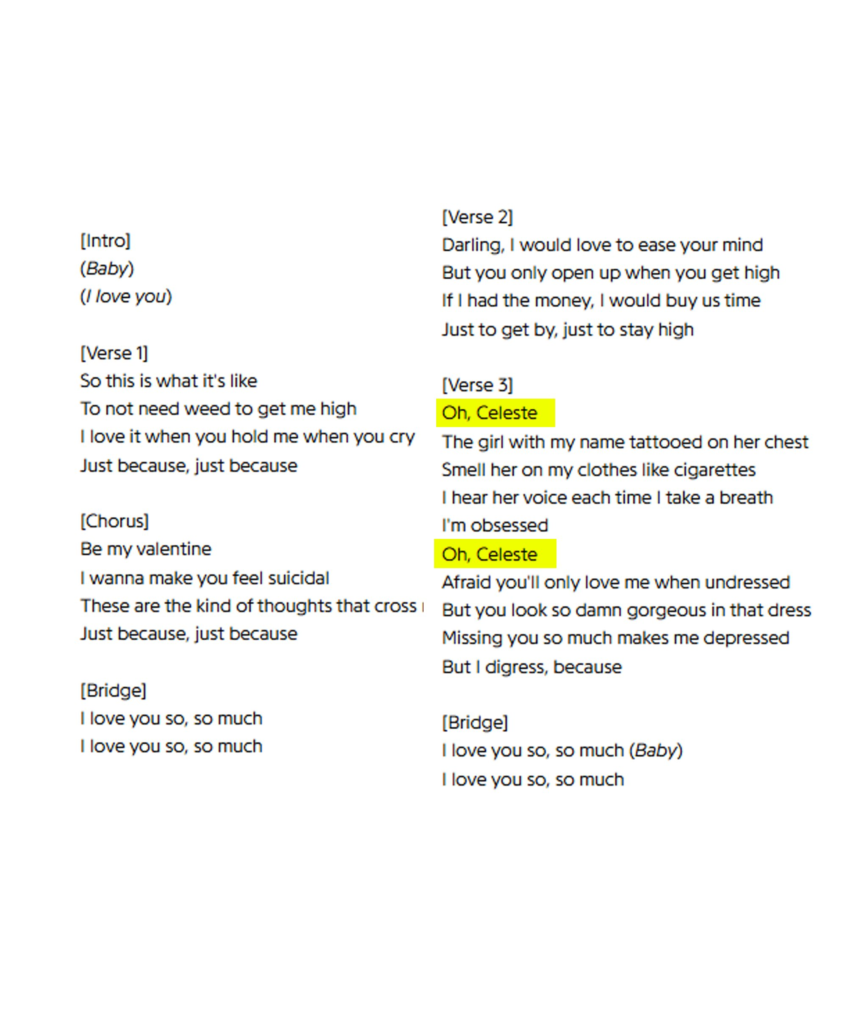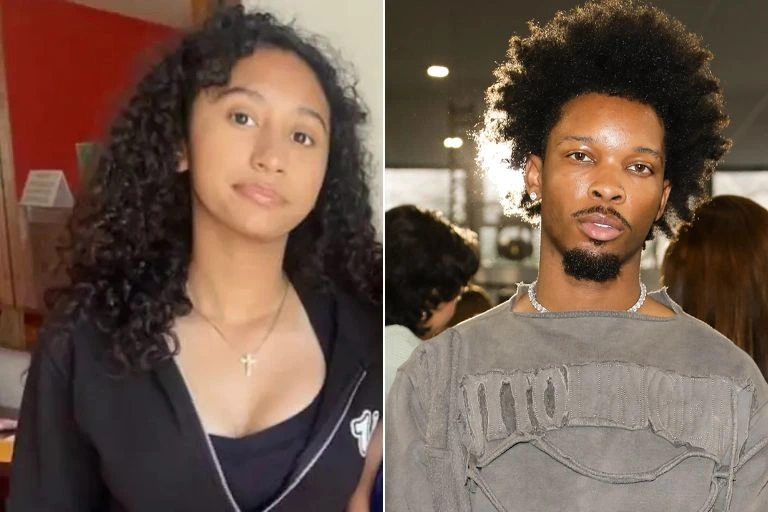On September 8, 2025, a tow yard worker in Los Angeles reported a stench coming from an abandoned Tesla with Texas plates. When LAPD opened the front trunk, they uncovered a bag containing dismembered remains.
The body was identified as 13-year-old Celeste Rivas Hernandez, who had been missing from Riverside County for more than a year.
The Tesla was registered to 20-year-old musician David Anthony Burke, better known as D4vd, whose viral hit Romantic Homicide had propelled him to international fame. Within hours, police raided a Hollywood Hills mansion linked to the artist, seizing evidence in what quickly became one of the most disturbing cases to collide music and crime in recent memory.

The Discovery in Hollywood Hills
The Tesla, a Model 3 with Texas plates, had been abandoned in the Hollywood Hills for weeks before being towed. When officers opened the front trunk, they found a large plastic-wrapped bag. Inside were dismembered human remains so gruesome that detectives said it was difficult to process.
The Los Angeles County Medical Examiner later confirmed the victim’s identity: 13-year-old Celeste Rivas Hernandez, missing since April 2024. For over a year, her family had searched for answers. Now, her body had been found under circumstances that pointed directly to one of music’s fastest-rising stars.
Within hours of the discovery, LAPD obtained a search warrant for a Hollywood Hills mansion linked to David. Neighbors told reporters the Tesla had been parked outside that property for months, the source of the odor that eventually drew law enforcement to it.
The mansion, rented under the name of David’s management, had served as his residence before he left for tour. Investigators spent more than twelve hours inside, collecting electronics, searching for traces of blood, and removing items for forensic testing. Officials later confirmed that multiple pieces of evidence were recovered and were being analyzed.
That night, word of the case began spreading online. By morning, the story had already gone national a teenage girl’s remains discovered in the car of a celebrity whose career seemed untouchable only days earlier.

Celeste’s Disappearance (2024)
The discovery in 2025 brought investigators back to April 2024, when Celeste Rivas Hernandez first vanished.
According to her family, the 13-year-old was last seen leaving her Riverside County home to watch a movie with her boyfriend. His name, they said, was David. Her brother Matthew recalled thinking she would be gone only a few hours, “munching popcorn with a classmate,” before realizing she never came home.
This was not the first time Celeste had gone missing. Two months earlier, in February 2024, she briefly disappeared before returning home. Each time, her absence appeared to be linked to the same older boy.
Her middle school teacher later told students an account later confirmed by both TMZ and her family that Celeste had confided to classmates she had met David online, run away with him, and been intercepted by police before being brought home.
The family’s missing person poster from April described Celeste as just a child she had been wearing Hello Kitty sandals.
By May 2024, she disappeared again. That time, she did not return.
Investigators now believe these early disappearances formed a pattern, one that pointed to grooming. In April 2024, David had just turned 19, while Celeste had only turned 13. The six-year gap placed her well below the age of consent in California.
Even before her body was found, the timeline had raised alarms. Police have long said they “do not believe in coincidences,” and the link between Celeste’s missing-person cases and the singer’s name was too strong to ignore.
Footage has resurfaced of D4vd talking with Celeste Rivas Hernandez on a livestream
pic.twitter.com/h31fewr6z0
— Daily Loud (@DailyLoud) September 20, 2025A Digital Trail Years in the Making
As investigators retraced Celeste’s final months, a disturbing pattern began emerging online. Far from being hidden, much of the evidence had been circulating in public spaces Discord chats, livestreams, and even TikTok comments long before her body was found.
The earliest trace dates back to 2022, when Celeste was just 12.
In a Discord chat tied to David’s fan community, the singer himself appeared and typed, “Celeste in here?” A user under her name replied: “Hi David.” The casual tone suggested this was not their first interaction.
A year later, in 2023, a leaked demo track surfaced online. Its title: Celeste. At the time, fans saw it as an ordinary creative choice. In hindsight, it now reads like a signal of something deeper.
By January 2024, more troubling evidence appeared. A livestream surfaced that showed David on camera with a girl resembling Celeste. During the broadcast, the girl could be heard saying, “We need to delete this.” David quickly turned to moderators and ordered: “Can we delete all vids?” The stream vanished in real time. But investigators later confirmed the clip had been saved by users before deletion.
In February 2024, David reposted a TikTok clip showing someone chopping raw meat. On-screen text read: “Me if I see her talk with other dudes.” It played as a joke, but with Celeste’s disappearance, the meaning took on a darker edge.
Under that very post, one fan left a chilling comment: “Waiting for LAPD to get your ass for messing with a 13-year-old girl.” That was months before Celeste’s remains were discovered in his car.
More connections kept surfacing. Photos from backstage events showed David alongside a young girl resembling Celeste. At least one image revealed they shared the same tattoo, a detail investigators later flagged as strong evidence of grooming.
For detectives, the digital trail painted a consistent picture interactions stretching back years, evidence of concealment, and public warnings ignored until it was too late.

Music, Imagery, and Hidden Confessions
As David’s fame grew, fans began re-examining his lyrics, visuals, and performances through a darker lens. What once looked like edgy creativity began to resemble a trail of confessions.
The clearest example came from his hit single Romantic Homicide. In it, David sang: “In the back of my mind, I killed you and I didn’t even regret it.” At the time, he told Forbes the lyrics were metaphorical, not literal. But after Celeste’s body was discovered in his Tesla, the words read differently.
The parallels extended into his music videos. His track One More Dance featured visuals of a body being dragged, stuffed into a trunk, and left for dead—eerily similar to how Celeste’s remains were found.
On tour, David performed under an alter ego named Itami, often appearing in blood-smeared shirts beside a casket. Fans initially dismissed it as theatrical staging, but prosecutors now view it as possible evidence of obsession with violent imagery.
Even his merchandise raised questions. Blood-splatter tees, sold as part of his branding, looked less like edgy fashion and more like a reference to the acts he was accused of committing.
Online sleuths also pointed to smaller details: TikToks captioned with phrases like “I miss her” and bizarre posts about cannibalism. Each piece, they argued, was another clue in plain sight.
Taken together, the songs, visuals, and stage persona painted a picture not just of a musician pushing boundaries, but of an artist possibly documenting and foreshadowing the crimes he would later be tied to.

The LAPD Investigation and Legal Standstill
Following the Tesla discovery, LAPD immediately secured David’s Hollywood Hills mansion and collected a wide range of evidence, including electronics, clothing, and other items that could link him to Celeste’s death.
Investigators spent over twelve hours meticulously searching the property.
Despite the mounting evidence, no charges have been filed against David. Prosecutors have explained that suspicion alone is insufficient they require concrete proof such as a confirmed cause of death, a coroner’s report, or unambiguous digital evidence linking him to the crime.
The condition of Celeste’s body complicates the autopsy, making it difficult to establish a definitive cause and manner of death.
Legal analysts have stressed the gap between public outrage and prosecutorial standards. Analyst Brian Buckmeer told Good Morning America, “Law enforcement does not yet have enough evidence to confront him, particularly without an autopsy report establishing cause and manner of death.” Retired detectives note that while the online trail appears damning, a court must weigh only verifiable evidence.
For investigators, the case is a balancing act. Public attention, leaked media, and social media speculation have amplified pressure, but any premature action could compromise a potential prosecution. Authorities have assured the public that multiple leads are being actively pursued, but caution remains the official stance.
Meanwhile, David’s career has begun collapsing under scrutiny. Tours have been canceled, brand partnerships terminated, and album releases frozen. Yet, the lack of charges leaves the question open how long can a high-profile suspect remain free while evidence continues to emerge?

The Collapse of a Career
The discovery of Celeste’s remains and the mounting digital evidence had immediate consequences for David’s career. Within days, his U.S. tour was canceled, followed by the removal of global tour dates. Promoters and venues swiftly pulled support, leaving his schedule in disarray.
Brands associated with him moved quickly. Partnerships with Crocs and Hollister were terminated, and his face was scrubbed from promotional campaigns. A scheduled appearance at the Grammy Museum vanished from the website, and a deluxe version of his latest album, which had been hyped on social media, was indefinitely delayed.
Despite the professional fallout, streaming numbers for his tracks paradoxically surged. Songs like Romantic Homicide and One More Dance saw increased plays, driven by public curiosity about the case. Analysts noted the tragic irony his scandal was fueling attention, even as the industry distanced itself.
For Celeste’s family, this was a bitter twist. Watching his career briefly climb amid evidence tying him to their daughter’s death added a layer of anguish to an already devastating loss. What had once been a rising musical star now stood as the center of an unfolding criminal investigation, his public persona inseparable from allegations of grooming and abuse.

The Family’s Grief and Public Outcry
For Celeste’s family, the discovery brought devastating confirmation of what they had feared for more than a year. Her brother Matthew posted on social media that she was “just a kid in Hello Kitty sandals,” a reminder of her age and innocence. The detail became a rallying symbol online, underscoring the imbalance of power between a 19-year-old rising star and a 13-year-old girl.
At vigils in Riverside County, friends and relatives gathered with candles and posters, demanding justice. Her mother wept as she told reporters: “She trusted someone she shouldn’t have. And the world needs to know what happened.”
The public response was swift and divided. Fans who had once idolized David began deleting his music from playlists, while others drawn by morbid curiosity searched for clues in his lyrics and videos. Hashtags like #JusticeForCeleste and #ProtectOurDaughters trended on TikTok and Twitter, amplifying the family’s call for accountability.
Advocacy groups also weighed in, pointing to Celeste’s case as part of a broader crisis of child grooming through social media and fan communities. “This isn’t just one tragedy,” one child safety advocate told NBC News. “It’s a wake-up call.”
What began as a private family nightmare had become a public reckoning—one that raised uncomfortable questions about how warning signs had been ignored, and whether justice would ever be served.
What Comes Next
As of October 2025, David Anthony Burke has not been formally charged. LAPD continues to analyze digital evidence, autopsy results, and forensic links between Celeste’s remains and the Hollywood Hills mansion. Detectives have stressed that “no stone will be left unturned,” but the case remains in limbo.
The unanswered questions are stark. How long had David and Celeste been in contact before her disappearance? Could earlier interventions during her first runaways have prevented her death? Why were online warnings, visible for months, not acted on sooner?
For prosecutors, the challenge is building a case that can stand in court, not just in the court of public opinion. The family, meanwhile, waits for closure, fearing delays could stretch into years.
Beyond the investigation, Celeste’s story has already altered conversations around celebrity culture and online grooming. Parents, teachers, and advocacy groups point to her case as a chilling reminder of how quickly digital relationships can escalate into real-world danger.
For now, the facts remain unresolved. A girl is gone, a pop star is under suspicion, and the world is left staring at an unfinished puzzle one in which every missing piece could determine whether justice is ever delivered.

